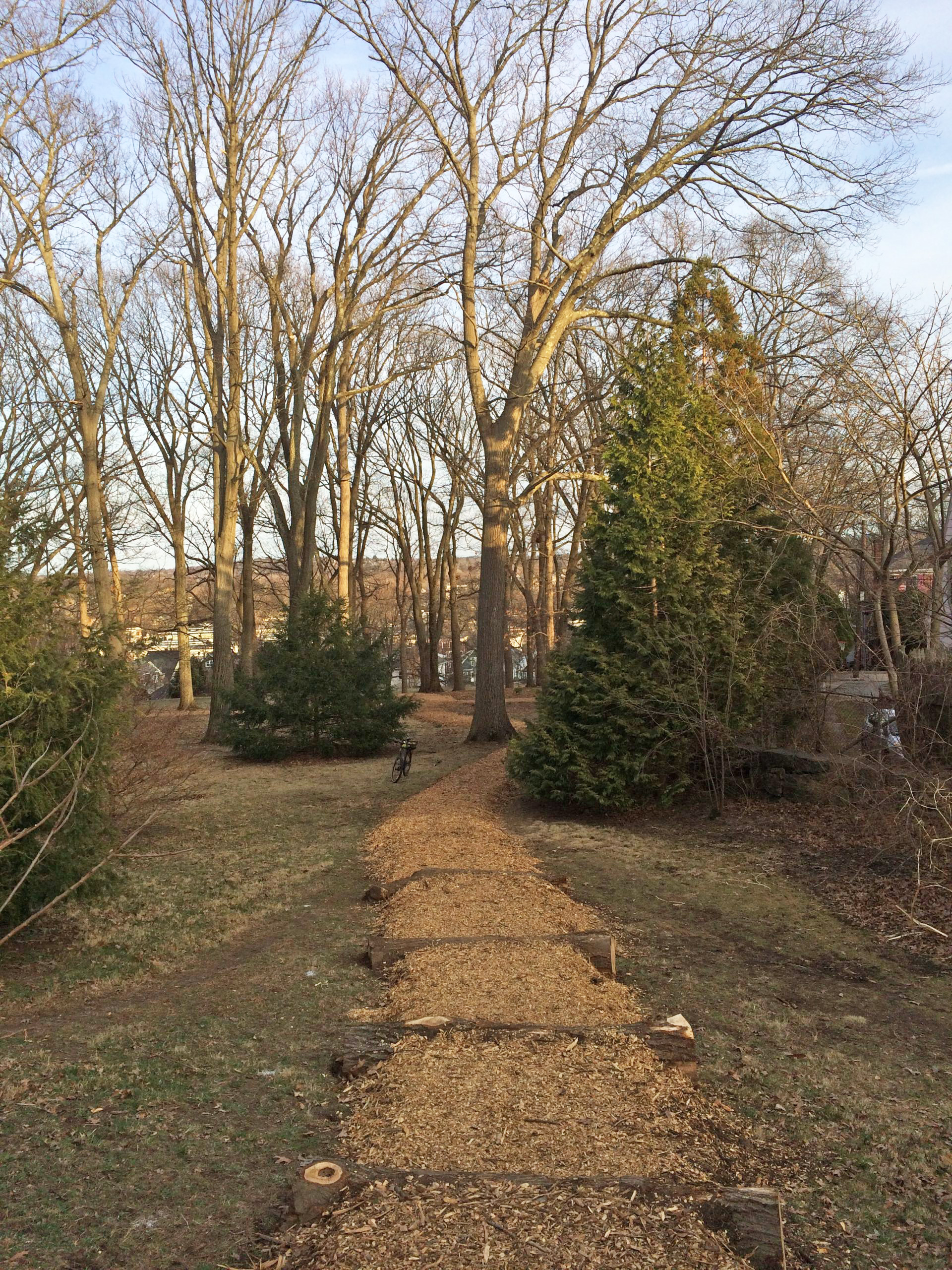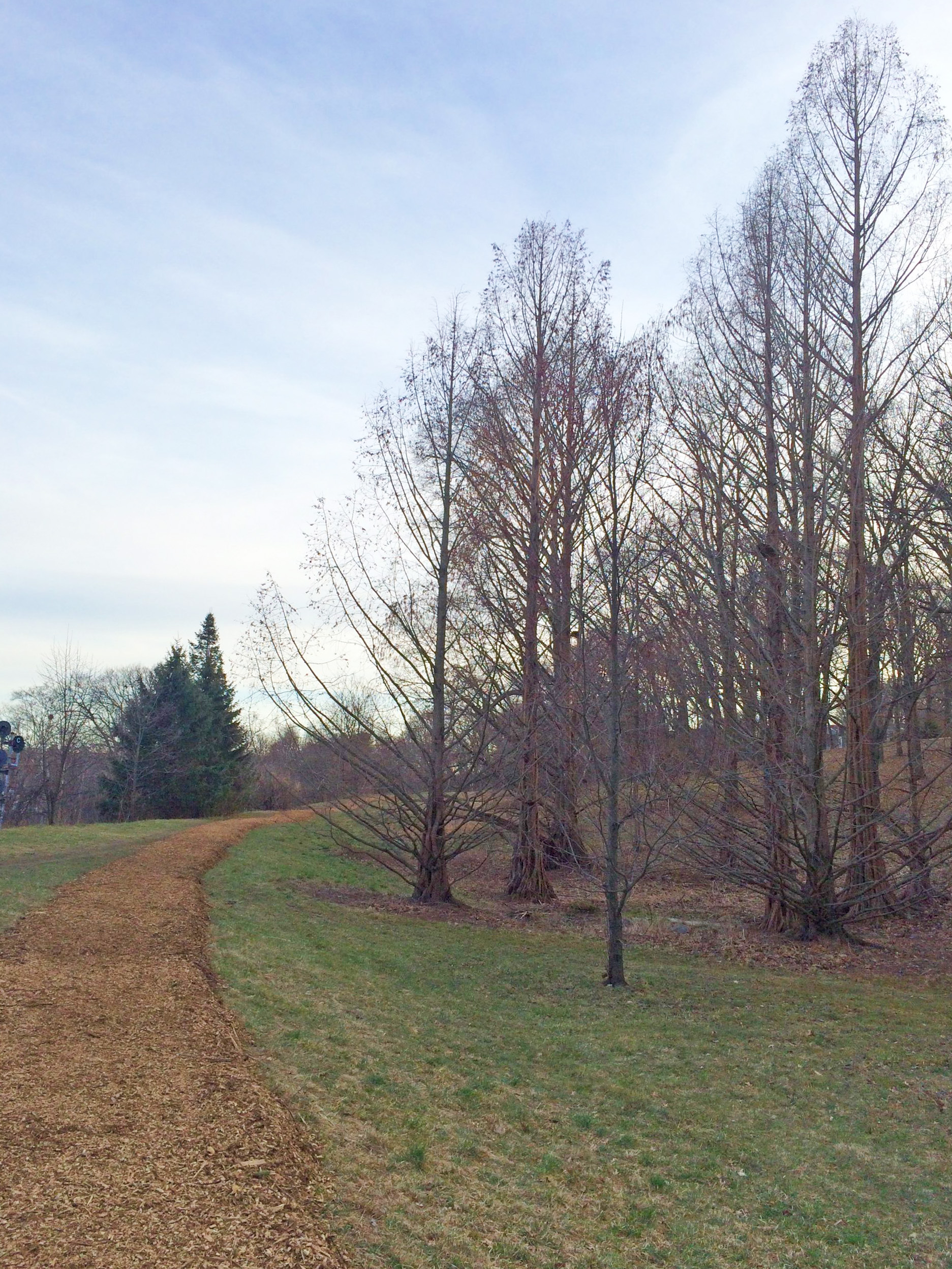Mulch paths (familiar features in the oak, viburnum, linden, and beech collections) are slowly expanding to improve collection accessibility on Peters Hill. The goal is to make it easier for walkers to visit novel parts of the landscape while safeguarding the health of our plants. Two new paths in particular hopefully afford new perspectives while renovating well trodden areas.

The first path provides better access to the Roslindale neighborhoods adjacent to the Archdale Road railroad bridge. For years, visitors taking this route into the collections entered through a rough step in the stone wall and onto a foot track, often either muddy from rain or caked hard from compaction. The mulch path renovation in this area traces a more scenic path into the collection that leads from the renovated stone wall entrance up the hill towards Poplar Street Gate.
The once steep hillside ascent, an area defined by ruts, erosion and compaction, is now tapered and buttressed by logs to control runoff and dampen the incline. Meanwhile, the towering oaks that abut the path on either side received some much needed care. Horticulturists used air spades to break up the rock hard compacted soil and incorporated a mix of leaf mold and compost to give the warn out trees a boost. The old, beaten footpaths were similarly smoothed out with fresh soil and reseeded with grass.

A second path takes visitors on a stroll from the Poplar Street Gate intersection towards the Mendum Street entrance. Roughly the same route as a proposed bike connection between Roslindale Village and the Forest Hills Train station, the path significantly improves sections of old foot tracks. While visitors once mainly walked along a dusty route near the commuter rail, the mulch path traces a route through a beautiful section of crabapple orchard, past a stand of dawn redwoods, and through a grove of large oaks. For those who wish to keep walking from Mendum Street, another path (leading through the white pine grove and towards Peter’s Hill Gate) begins across the road.
A highlight of this path is a view of one of the oldest groves of dawn redwoods in North America. This grove of trees, planted in 1948, were among the first of the species introduced into the Arboretum’s collections. Unfortunately, they grew in relative obscurity around a naturally occurring seep, due to the early misconception that dawn redwoods required wetland habitat to thrive (we now know this species tolerates a wide range of soil conditions). The new path offers a beautiful view of the grove, which will only become better as their needles flush out with green in the coming weeks.
While the mulch paths do deviate from decades of established (and likely well loved) foot tracks, they do so intentionally and with reason. First, the overall purpose of each path is to lead visitors to parts of the collections they might otherwise not have explored. Second, they channel foot traffic away from sensitive plants and their roots zones, mitigating the damage caused by soil compaction. Finally, they allow horticulturists to move equipment throughout areas of the collection which were previously difficult to access without damaging plants.

If you come out to explore these new routes, please be aware that the mulch paths are much narrower than the paved roadways. It is your responsibility to maintain six feet social distancing from the people with whom you interact; be considerate and respectful of other visitors. However, even in this challenging environment, we hope that these renovated walkways can provide the opportunity for a relaxing stroll and a more enjoyable experience in the Arboretum overall.
From “free” to “friend”…
Established in 1911 as the Bulletin of Popular Information, Arnoldia has long been a definitive forum for conversations about temperate woody plants and their landscapes. In 2022, we rolled out a new vision for the magazine as a vigorous forum for tales of plant exploration, behind-the-scenes glimpses of botanical research, and deep dives into the history of gardens, landscapes, and science. The new Arnoldia includes poetry, visual art, and literary essays, following the human imagination wherever it entangles with trees.
It takes resources to gather and nurture these new voices, and we depend on the support of our member-subscribers to make it possible. But membership means more: by becoming a member of the Arnold Arboretum, you help to keep our collection vibrant and our research and educational mission active. Through the pages of Arnoldia, you can take part in the life of this free-to-all landscape whether you live next door or an ocean away.
